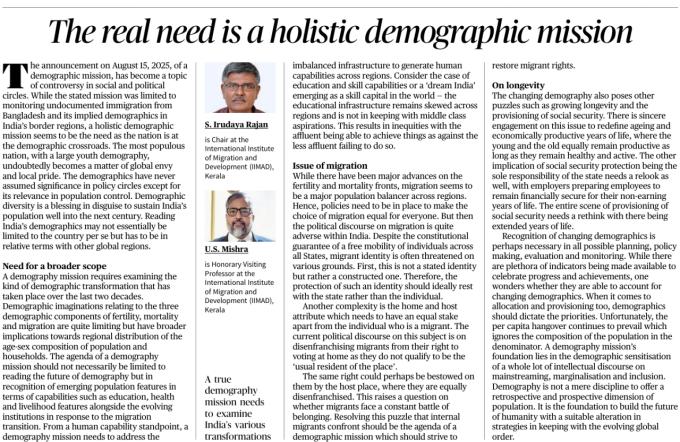Such a mission would help India translate its demographic diversity into economic and social strength, ensuring inclusive growth across regions.
Need for a Broader Scope
India’s demographic landscape has changed drastically over the past two decades.
While fertility rates have fallen and life expectancy increased, migration and ageing are emerging as critical issues.
A comprehensive demographic mission should thus:
1. Examine the regional imbalances in fertility and mortality transitions. 2. Study migration patterns, both internal and cross-border.
3. Integrate capability development — education, health, and livelihood opportunities — across regions.
4. Recognise demographic diversity as a national asset for long-term sustainability.
Regional Demographic Imbalances India’s large youth population is unevenly distributed:
- Southern and Western India are entering a phase of demographic ageing, with declining fertility rates below replacement levels.
- Northern and Eastern regions, particularly Uttar Pradesh, Bihar, and Jharkhand, continue to have higher fertility and dependency ratios.
This demographic skew impacts: - Labour mobility and productivity
- Educational and healthcare infrastructure
- Regional economic disparity
Thus, a demographic mission must go beyond counting people to building human capability infrastructure.
Issue of Migration Migration serves as a population balancer across regions but also creates identity and governance challenges.
Despite the constitutional guarantee of free movement, migrant identity often becomes politicised.
Migrants face dual exclusion:
- Disenfranchised in their home states (lose voting rights as they move).
- Marginalised in host regions (lack access to social welfare).
The article argues for: - Policy harmonisation between home and host states.
- Protection of migrant rights, including access to housing, health, and labour benefits.
- Recognition of migration as an essential driver of demographic equilibrium, not merely a social problem.
Demographic Ageing and Longevity - Rising life expectancy implies longer years of productivity and dependency.
- Social security systems, currently centred on state support, need rethinking to involve employer responsibility for financial and health security of retired workers.
A sustainable approach requires: - Redefining old-age productivity — promoting active ageing.
- Revisiting pension and health insurance models to reduce pressure on the state.
- Encouraging private sector participation in long-term care and pension coverage.
On Social Security and Policy Implications The changing demographic structure calls for: 1. Integration of demographic data into planning and policy evaluation. 2. A shift from population control to population capability enhancement. 3. A cross-sectoral approach combining education, employment, healthcare, migration, and social security. A true demographic mission would involve demographic sensitisation — mainstreaming inclusion, marginalisation, and regional parity into policymaking.
- A holistic demographic mission must blend data, inclusion, and long-term social vision.
UPSC Mains Q.
“India’s demographic challenge is not one of numbers but of inclusion and capability distribution.” Discuss in the context of the need for a holistic demographic mission.
Crime patterns: The 2023 NCRB report shows rise in cybercrime and crimes against tribals
Syllabus Mapping
GS Paper II – Governance & Polity: Mechanisms, Laws, and Institutions for Crime Prevention, Government Policies for Vulnerable Sections. GS Paper III – Internal Security: Challenges to Internal Security through Communication Networks, Role of Cybersecurity and Technological Threats.
Context
The National Crime Records Bureau (NCRB) released its Annual Crime Report for 2023, highlighting key national trends and emerging areas of concern in India’s law and order landscape.
While crime data often varies across States due to differences in reporting and registration, the report still offers valuable insights into policy-relevant trends — including rising cybercrime, increased crimes against Scheduled Tribes (STs), and a continued rise in crimes against children.
About the NCRB
- Established: 1986 under the Ministry of Home Affairs (MHA).
- Mandate: To collect, analyse, and disseminate crime data to assist in policy formulation and improve policing efficiency.
- Reports Published:
- Crime in India (CII)
- Prison Statistics India (PSI)
- Accidental Deaths & Suicides in India (ADSI)
Key Highlights from NCRB 2023 Report 1. Overall Crime Trends
- Murder cases decreased by 2.8% across India.
- The fall in murder cases is largely attributed to improved dispute resolution mechanisms and faster law enforcement responses.
- However, there has been a worrying surge in targeted crimes, especially against vulnerable groups and in cyberspace.
2. Crimes Against Scheduled Tribes (STs) - Crimes against STs surged by 28.8% in 2023.
- Major contributors:
- Ethnic violence in Manipur, where cases rose from 1 (2022) to 3,399 (2023).
- High rates in Madhya Pradesh and Rajasthan, indicating persistent vulnerabilities among tribal populations.
- Most cases relate to land disputes, social discrimination, and political violence.
- NCRB data shows this as a recurring pattern in tribal-dominated central Indian regions (Chhattisgarh, Jharkhand, Odisha).
Policy Relevance: - Indicates weak implementation of the Scheduled Castes and Scheduled Tribes (Prevention of Atrocities) Act, 1989.
- Calls for targeted community policing, ethnic conflict mitigation, and inclusive development in tribal areas.
3. Rise in Cybercrime (↑ 31.2%) - Cybercrimes registered a 31.2% increase compared to 2022.
- Key categories include:
- Financial frauds and phishing scams through digital payments and investment apps.
- Online sexual exploitation and cyberstalking.
- The deepening of digital infrastructure and increased UPI transactions have widened the risk landscape.
Government Initiatives on Cybercrime: - Cyber Crime Prevention against Women & Children (CCPWC) Scheme, MHA.
- Indian Cyber Crime Coordination Centre (I4C) established in 2018 — coordinates national cybercrime investigation efforts.
- National Cyber Crime Reporting Portal (cybercrime.gov.in).
- Cyber Swachhta Kendra (Botnet Cleaning and Malware Analysis Centre) by CERT-In.
- Cyber Surakshit Bharat Initiative (MeitY) to strengthen cyber hygiene in government departments.
Policy Need: - Establishment of dedicated cyber forensic units.
- Integration of AI-based predictive policing for real-time fraud detection.
- Inclusion of digital literacy programs in school and college curricula.
4. Crimes Against Children (↑ 9.2%) - Crimes against children rose 9.2% in 2023, with 96% of offenders known to the victim — a stark reminder of intra-family and community vulnerability.
- Total registered cases: 1,77,335.
- Possible reasons:
- Improved awareness and reporting.
- Increased digital exposure.
- Continued exploitation by relatives, neighbours, or teachers.
Relevant Legislation & Schemes: - Protection of Children from Sexual Offences (POCSO) Act, 2012 — to safeguard children from sexual exploitation.
- Beti Bachao Beti Padhao (BBBP) — for girl child protection and empowerment.
- National Child Protection Policy (Draft, 2021) — to institutionalise child safety norms.
- e-POCSO Courts and One Stop Centres (OSCs) under the Nirbhaya Fund.
5. Crimes Against Women - Marginal overall increase of 0.4%, but within this:
- Dowry-related crimes rose by 14.9% — suggesting persistence of social evils despite legal safeguards.
- The NCRB notes that many States underreport domestic violence and workplace harassment.
Government Measures: - One Stop Centres (OSCs) for integrated support (counselling, police, legal, and medical aid).
- Women Helpline (181).
- Mahila Police Volunteers Scheme for grassroots support.
- Nirbhaya Fund for safety infrastructure (CCTV, SOS apps, etc.).
Broader Analysis Key Concerns 1. Underreporting & Data Lag: Delay in NCRB reporting undermines timely policy intervention.
2. Implementation Gaps: Legal frameworks like POCSO, IT Act, and SC/ST Act face weak enforcement.
3. Digital Policing Deficit: Lack of skilled cyber forensic experts at state and district levels.
4. Regional Disparities: States with poor law enforcement capacity show higher vulnerability in tribal and gender-based crimes.
Way Forward
1. Modernisation of Policing: o Implement SMART Policing principles (Sensitive, Modern, Accountable, Reliable, Tech-savvy). o Strengthen CCTNS (Crime and Criminal Tracking Network System) integration across States.
2. Capacity Building: o Regular cyber training for police and judiciary. o Recruitment of data analysts and forensic experts in police departments. 3. Community Engagement: o Awareness drives in rural and tribal areas on cyber fraud, women’s safety, and child protection. o Strengthen collaboration between police, NGOs, and schools.
4. Fast-Track Justice: o Expand fast-track courts for POCSO and cyber fraud cases. o Promote ADR (Alternative Dispute Resolution) for minor disputes to reduce case burden.
UPSC Mains Q. The 2023 NCRB report reveals a worrying surge in cybercrime and crimes against vulnerable groups such as tribals and children. Critically examine the underlying causes and evaluate the effectiveness of India’s legal and institutional mechanisms in addressing these trends.
India’s Kabul mission to be upgraded to embassy 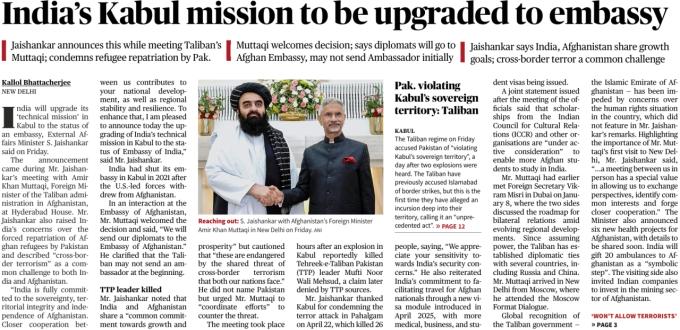
Syllabus Mapping
GS Paper II – International Relations: India and its Neighbourhood Relations, Bilateral, Regional, and Global Groupings and Agreements, Effect of Policies and Politics of Developing Countries on India’s Interests, India’s Foreign Policy — Neighbourhood First Policy
Context External Affairs Minister S. Jaishankar announced that India will upgrade its ‘Technical Mission’ in Kabul to the status of a full-fledged Embassy of India.
The decision came during his meeting with Amir Khan Muttaqi, the Taliban’s Foreign Minister, at Hyderabad House in New Delhi — marking a significant step in India’s cautious diplomatic engagement with Afghanistan’s Taliban-led administration.
Background
- India had shut down its embassy in Kabul in August 2021, following the U.S. withdrawal from Afghanistan and the Taliban’s takeover.
- A technical mission was later set up in 2022 to oversee humanitarian assistance and development projects.
- The current decision to restore the embassy status signifies New Delhi’s intent to re-engage diplomatically while balancing concerns over legitimacy, human rights, and regional security.
Core Details & Key Developments Upgrading Diplomatic Status - The move elevates India’s engagement from limited technical support to a formal diplomatic mission.
- The Taliban welcomed the decision and stated it would send diplomats to the Afghan Embassy in India, although an ambassador may not be appointed initially.
Shared Priorities Mr. Jaishankar underlined that India and Afghanistan share:
- Common growth goals
- Regional stability and resilience
- Commitment to countering cross-border terrorism — a reference to threats from Pakistan-based groups like the Tehreek-e-Taliban Pakistan (TTP).
Pakistan’s Role and Security Context - The Taliban regime accused Pakistan of violating Afghanistan’s sovereignty, alleging cross-border strikes into Afghan territory — an unusual public charge.
- This development comes amid Taliban–Pakistan tensions following the death of a TTP leader in Kabul.
Humanitarian and Development Cooperation - India reaffirmed its commitment to facilitating Afghan nationals’ access through the e-Visa module (launched in April 2025) for students and medical cases.
- Scholarships via the Indian Council for Cultural Relations (ICCR) and other institutions are under active consideration to support Afghan students.
- India also announced six new health projects and will gift 20 ambulances to Afghanistan as a symbolic humanitarian gesture.
- Indian companies are being encouraged to invest in Afghanistan’s mining sector.
Strategic Significance - The move signals India’s re-entry into Afghanistan’s geopolitical sphere, balancing humanitarian engagement with strategic caution.
- It reflects India’s effort to retain influence in the region amid increasing presence of China, Russia, and Pakistan in Taliban-ruled Afghanistan.
- This also aligns with India’s long-term interests in regional connectivity, counterterrorism, and Central Asian outreach.
Challenges Ahead - Recognition dilemma: India still does not officially recognize the Taliban regime.
- Human rights issues and women’s rights suppression remain concerns.
- Security risks persist for Indian personnel due to instability and extremist threats.
UPSC Prelims Q. India recently announced plans to upgrade its ‘Technical Mission’ in which of the following countries to the status of a full-fledged Embassy?
(a) Myanmar
(b) Afghanistan
(c) Iran
(d) Sri Lanka
Answer: (b) Afghanistan

Venezuela’s Opposition leader María Machado wins Nobel Peace Prize ‘promoting democracy’ 
Syllabus Mapping
GS Paper II: International Relations – Role of international organizations and awards in promoting global values of democracy and human rights. GS Paper I: Modern world history – Events influencing political ideologies and governance globally.
Context
Venezuelan Opposition leader María Corina Machado has been awarded the 2025 Nobel Peace Prize for her unwavering struggle to achieve a democratic transition in Venezuela, a country long under authoritarian rule. The Norwegian Nobel Committee recognized her as a “key, unifying figure” who continues to uphold the flame of democracy amid growing darkness, despite repression and threats from President Nicolás Maduro’s regime.
Core Details
- Awarded for: Promoting democracy and human rights in Venezuela.
- Significance: Machado symbolizes democratic resistance and civic courage in Latin America’s ongoing struggle against authoritarianism.
- Challenges faced:
- Disqualified by the Maduro regime from contesting presidential elections.
- Subjected to surveillance, intimidation, and violent crackdowns on dissent.
- Continued to advocate for peaceful democratic transition despite personal threats.
The Nobel Committee praised her
“courageous defense of freedom” and commitment to democratic ideals, calling her leadership vital in uniting a divided opposition.
UPSC Prelims Q. Who was awarded the Nobel Peace Prize for the year 2025 for promoting democracy?
(a) Juan Guaidó
(b) Nicolás Maduro
(c) María Corina Machado
(d) Hugo Chávez
Answer: (c) María Corina Machado
Hydropower project on Chenab gets clearance Syllabus Mapping
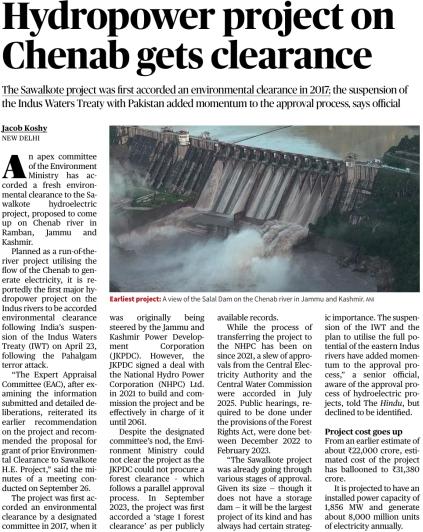
- GS Paper III – Environment & Energy:
- Conservation, Environmental Impact Assessment
- Renewable Energy Sources – Hydropower Development
- Infrastructure: Energy and Investment Models
Context The Sawal Kote Hydroelectric Project on the Chenab River in Ramban district, Jammu and Kashmir, has received fresh environmental clearance from the Ministry of Environment, Forest and Climate Change (MoEFCC).
This clearance comes after India’s suspension of the Indus Waters Treaty (IWT) with Pakistan, which added momentum to pending hydropower approvals in the Indus basin.
About the Sawal kote Hydroelectric Project
- Type: Run-of-the-river hydroelectric project (no major reservoir storage).
- Location: Chenab River, Ramban district, Jammu & Kashmir.
- Implemented by: National Hydro Power Corporation (NHPC) Ltd.
- Installed Capacity: 1,856 MW (projected annual generation of 8,000 million units).
- Cost: Increased from ₹22,000 crore (earlier estimate) to ₹31,380 crore due to cost escalations.
- Timeline: Construction and operation expected until 2061 under NHPC supervision.
Background and Evolution - Initially, the project was developed by the Jammu and Kashmir Power Development Corporation (JKPDC).
- In 2021, JKPDC transferred the project to NHPC for construction and management.
- The project was first accorded environmental clearance in 2017, but work stalled due to procedural lapses and the need for multiple statutory approvals — including those under the Forest Rights Act and from the Central Water Commission (CWC) and Central Electricity Authority (CEA).
- Final statutory clearances were completed between December 2022 and February 2023.
Strategic and Environmental Significance Strategic Context - The Indus Waters Treaty (1960) allocates the western rivers (Indus, Jhelum, Chenab) largely to Pakistan, while India retains limited rights for run-of-the-river projects.
- Following India’s suspension of IWT implementation (April 2023) amid security tensions and the Pahalgam terror attack, hydropower projects in the Indus basin — like Sawalkote — gained fresh urgency as symbols of strategic and sovereign water use.
Environmental and Economic Importance - The project’s environmental clearance underscores India’s commitment to clean and renewable energy, contributing to national targets under COP21 (Paris Agreement) and Nationally Determined Contributions (NDCs).
- It will create local employment, boost regional infrastructure, and enhance energy security in the Union Territory.
- Environmental concerns, such as impacts on river ecology, aquatic biodiversity, and downstream flow regulation, are to be mitigated under strict monitoring conditions laid out by the Expert Appraisal Committee (EAC).
Project Progress and Implementation Challenges - Transfer of ownership and procedural hurdles caused significant delays in approvals.
- As per officials, the suspension of the IWT acted as a policy catalyst to expedite hydro projects in India’s western river basins.
- The Sawalkote project is among the largest hydroelectric ventures on the Chenab and will enhance India’s strategic leverage in Indus basin management.
UPSC Prelims Q. The recently cleared
SawalKote Hydroelectric Project is proposed to be built on which river?
(a) Jhelum
(b) Ravi
(c) Chenab
(d) Beas
Answer: (c) Chenab
6 State-level RTI panels are defunct; appeals can take years to be heard: report
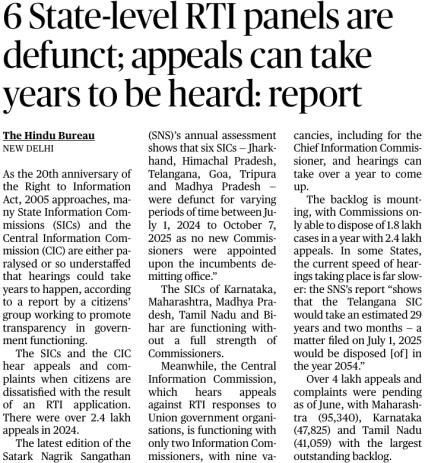
Context As India marks 20 years of the Right to Information (RTI) Act, 2005, a recent assessment by the Satark Nagrik Sangathan (SNS) has revealed a severe institutional paralysis in the functioning of several State Information Commissions (SICs) and the Central Information Commission (CIC).
The report highlights the growing backlog of RTI appeals and complaints across the country, which threatens the transparency and accountability framework established under the RTI Act.
About the Issue
- According to the SNS’s 2025 annual assessment, six State Information Commissions — Jharkhand, Himachal Pradesh, Telangana, Goa, Tripura, and Madhya Pradesh — were defunct between July 1, 2024, and October 7, 2025, as no new commissioners were appointed after the incumbents demitted office.
- The absence of commissioners means no hearings are being conducted, leaving thousands of appeals and complaints unresolved.
- Even in functioning states such as Karnataka, Maharashtra, Tamil Nadu, Bihar, and Madhya Pradesh, the SICs operate without full strength, further slowing down the grievance redressal process.
Central Information Commission (CIC) Situation - The CIC, which handles RTI appeals and complaints related to Union Government bodies, is also severely understaffed, operating with only two functional members, while the sanctioned strength is much higher.
- Several vacancies, including that of the Chief Information Commissioner, remain unfilled.
- As a result, hearings can take over a year to come up, undermining the spirit of time-bound transparency envisaged in the RTI Act.
RTI Backlog and Data - India saw 2.4 lakh RTI appeals and complaints in 2024.
- The commissions could dispose of only 1.8 lakh cases, adding to an ever-increasing backlog.
- As of June 2025, over 4 lakh appeals were pending across the country:
- Maharashtra: 95,340
- Karnataka: 47,825
- Tamil Nadu: 41,059
The SNS report notes that, at the current rate, Telangana’s SIC would take 29 years and two months to clear its existing backlog — meaning a complaint filed in 2025 would be resolved only by 2054.
Implications for Transparency
- Right to Information is a cornerstone of democratic accountability, empowering citizens to question governance.
- Non-functioning or delayed RTI hearings weaken public trust and erode administrative transparency.
- The backlog indicates a failure to institutionalize transparency, contrary to the RTI Act’s objective of promoting open government.
UPSC Prelims Q. Which of the following institutions is responsible for adjudicating appeals under the Right to Information Act, 2005?
(a) Central Vigilance Commission
(b) Central Information Commission
(c) National Human Rights Commission
(d) Lokpal of India
Answer: (b) Central Information Commission
Supreme Court hints at revisiting firecracker ban in Delhi-NCR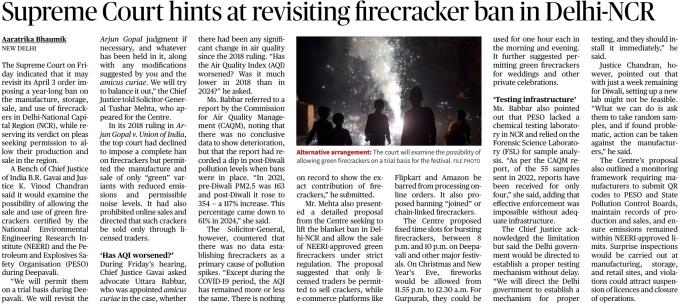
Syllabus Mapping
- GS Paper II – Polity and Governance:
- Role of Judiciary in Environmental Protection
- Government Policies and Regulatory Frameworks
- GS Paper III – Environment:
- Environmental Pollution and Control
- Air Quality Management and Sustainable Technologies
Context The Supreme Court of India has indicated that it may revisit its April 3, 2024, order which imposed a year-long ban on the manufacture, storage, sale, and use of firecrackers in the Delhi–National Capital Region (NCR).
The move comes in response to petitions seeking permission to allow the production and limited sale of green firecrackers certified by the National Environmental Engineering Research Institute (NEERI) and the Petroleum and Explosives Safety Organisation (PESO) during festive seasons like Deepavali.
Background
- The issue of firecrackers and air pollution has been a recurring concern, especially in Delhi-NCR, which records severe Air Quality Index (AQI) during winters and festivals.
- In 2018, in the landmark case Arjun Gopal v. Union of India, the Supreme Court declined to impose a blanket ban on firecrackers but restricted the sale to “green crackers” — variants with reduced emissions and permissible noise levels.
- The 2018 order also prohibited online sales and directed that firecrackers could only be sold through licensed traders.
Current Developments A Bench headed by Chief Justice of India B.R. Gavai and Justice K. Vinod Chandran stated that it would consider allowing the limited sale and use of NEERI-certified green firecrackers under strict monitoring.
Solicitor-General Tushar Mehta, representing the Centre, argued that firecrackers were not the primary source of pollution spikes in NCR and sought a partial lifting of the existing ban.
Air Quality Concerns and Data
- The Bench questioned whether the AQI had worsened since 2018, asking if there was empirical evidence that justified a continued complete ban.
- Commission for Air Quality Management (CAQM) data indicated no conclusive evidence directly linking firecracker emissions to pollution spikes.
- However, post-Diwali PM2.5 levels continue to show sharp rises — in 2021, PM2.5 levels increased by 117% post-Diwali (from 163 to 354 µg/m³).
- In contrast, 2024 figures indicated a 61% rise, suggesting marginal improvement.
Testing and Regulatory Infrastructure - The PESO reportedly lacks a dedicated chemical testing laboratory in NCR, relying instead on the Forensic Science Laboratory (FSL) for sample analysis.
- Out of 55 samples tested in 2022, results were received for only four, highlighting serious implementation gaps.
- The Supreme Court directed the Delhi Government to establish a proper testing mechanism to verify whether “green firecrackers” actually meet emission standards.
- The Centre also proposed a QR code-based monitoring framework to ensure traceability in manufacturing, retailing, and emissions compliance.
Centre’s Proposals to the Court 1. Allow NEERI-approved green firecrackers under licensed supervision. 2. Ban online sales via e-commerce platforms like Flipkart and Amazon. 3. Permit fireworks during fixed time slots
4. Strict action against violating manufacturers, including suspension of licenses and closure of operations.
Judicial Observations
- The CJI stated that the Court would revisit the Arjun Gopal judgment if needed, to strike a balance between environmental protection and cultural practices.
- Justice Chandran added that random sampling of firecrackers should be done to ensure compliance and that non-compliant units could face immediate penalties.
Significance - The review highlights the Court’s evolving approach toward balancing public health and festive rights.
- It reflects an effort to integrate scientific data and regulatory capacity into environmental decision-making, rather than imposing blanket bans.
UPSC Prelims Q. The term “Green Firecrackers” recently seen in the news refers to:
(a) Firecrackers made of biodegradable materials
(b) Firecrackers that emit reduced emissions and permissible noise levels
(c) Firecrackers using hydrogen as fuel
(d) Firecrackers that are free of carbon compounds
Answer: (b) Firecrackers that emit reduced emissions and permissible noise levels
Ministry of Minority Affairs Launches Skilling Project under PM VIKAS Scheme in Kerala
Syllabus: GS Paper 2 – Governance (Welfare Schemes for Vulnerable Sections)
Context:
In October 2025, the Ministry of Minority Affairs launched a skilling project under the Pradhan Mantri Virasat Ka Samvardhan (PM VIKAS) scheme in partnership with IIT Palakkad. The initiative aims to empower minority communities in Kerala by equipping youth with advanced technical and industry-relevant skills. Key Points:
- Implementing Ministry: Ministry of Minority Affairs, Government of India.
- Implementing Partner: Indian Institute of Technology (IIT) Palakkad.
- Objective: To promote socio-economic empowerment of minority communities through skill development and employment generation.
- About PM VIKAS Scheme:
- A flagship programme for the socio-economic upliftment of minority communities
- Focuses on skill development, entrepreneurship, and livelihood creation.
- Aims to foster inclusive growth and align with India’s innovation and digital development goals.
- Scope of the Programme:
- Total Beneficiaries: 400 candidates from minority communities in Kerala.
- Training Areas:
- Junior Chip Designing – 150 trainees
- Embedded Software Engineering – 150 trainees
- Junior Engineering in Drone R&D – 100 trainees
- Funding and Support: The Ministry will fully fund the programme, including training costs and stipends for participants.
- Expected Outcome: To create a future-ready workforce skilled in emerging technology sectors, enhancing employability and entrepreneurship among minority youth.

Source: PIB
Surrogacy (Regulation) Act, 2021
Syllabus: GS Paper 2 – Polity & Governance (Government Policies and Legislation) Context: The Supreme Court recently ruled that age limits prescribed under the Surrogacy (Regulation) Act, 2021 do not apply to couples who had frozen their embryos and initiated the surrogacy process before the law came into effect on January 25, 2022. Key Points:
- Regulating Body: Surrogacy in India is governed by the Surrogacy (Regulation) Act, 2021.
- Objective: The Act aims to prevent exploitation of women and ensure ethical practices in surrogacy arrangements.
- Type of Surrogacy Permitted: Only altruistic surrogacy is allowed, where the surrogate mother receives no monetary benefit other than medical and insurance expenses.
- Prohibition of Commercial Surrogacy: The Act bans commercial surrogacy to stop misuse and unethical practices.
- Regulation of Clinics:
- Only registered clinics can perform surrogacy procedures.
- Unregistered entities or medical practitioners are prohibited from engaging in surrogacy activities.
- Conditions for Surrogate Mother:
- Must be a married woman with at least one biological child.
- Age between 25–35 years at the time of implantation.
- Cannot use her own gametes or act as a surrogate more than once.
- Eligibility of Intended Couple:
- Must be Indian nationals and legally married for at least 5 years.
- Woman: 23–50 years; Man: 26–55 years.
- Should not have any surviving children, biological, adopted, or from prior surrogacy.
- Certificate of Essentiality: Surrogacy can proceed only after obtaining certification from the competent authority.
- Abortion Clause: Termination during surrogacy requires written consent from the surrogate mother and approval of registered medical practitioners.
- Legal Status of Child: The child born through surrogacy is deemed the biological child of the intended couple and enjoys all legal rights and privileges.

Source: The Hindu
DRAVYA Portal
Syllabus: GS Paper 2 – Governance (Government Initiatives in Health & AYUSH Sector) Context: In its first phase, the DRAVYA portal aims to catalogue information on 100 key medicinal substances, strengthening research and standardisation in Ayurvedic and AYUSH systems of medicine.
Key Points:
- Full Form: DRAVYA stands for Digitized Retrieval Application for Versatile Yardstick of AYUSH Substances.
- Developed By: It is an initiative of the Central Council for Research in Ayurvedic Sciences (CCRAS).
- Objective: To create the largest digital database on Ayurvedic ingredients and products, integrating classical and modern scientific data.
- Database Scope:
- Covers classical Ayurveda texts, scientific literature, and field studies.
- Acts as an ever-growing and evolving repository of medicinal substances.
- AI-Ready Platform: Designed to be AI-compatible and will interlink with the Ayush Grid and other Ministry of AYUSH initiatives related to drug policy and medicinal substances.
- QR Code Integration: Enables standardised display of information in medicinal plant gardens and drug repositories across India.
- Open-Access Database: Provides comprehensive, searchable information on medicinal substances used across Ayush systems.
- Information Coverage: Offers detailed profiles including pharmacotherapeutics, botany, chemistry, pharmacy, pharmacology, and safety data.
Source: PIB
Syllabus: GS Paper 3 – Science & Technology (Applications in Agriculture and Environment)
Context: The
Ministry of Electronics and Information Technology (MeitY) has recently announced the
transfer of technology under the AgriEnIcs Programme, aimed at advancing digital innovation in
agriculture and environmental management.
Key Points: - Implementing Ministry: The programme is a national initiative of MeitY.
- Objective: To promote research, development, deployment, demonstration, and commercialization of advanced technologies in the agriculture and environment sectors.
- Purpose: Serves as a national platform for R&D and technology translation, enabling sustainable agricultural and environmental practices.
- Technological Integration: Incorporates Artificial Intelligence (AI), Internet of Things (IoT), machine vision, and sensor networks to enhance digital precision and efficiency in agriculture.
- Collaborative Framework: Brings together research institutions, industries, and government agencies for innovation and field-level implementation.
- Nodal Agency:
- Implemented by the Centre for Development of Advanced Computing (C-DAC), Kolkata.
- Supported by academic institutes, R&D laboratories, and industry partners.
- About C-DAC:
- Established in 1988 as the apex R&D wing of MeitY.
- Created to conduct research in Electronics and Information Technology.
- Founded after the denial of supercomputer imports by the USA.
- Developed India’s first indigenous supercomputer, PARAM 8000, in 1991.
Source: PIB




